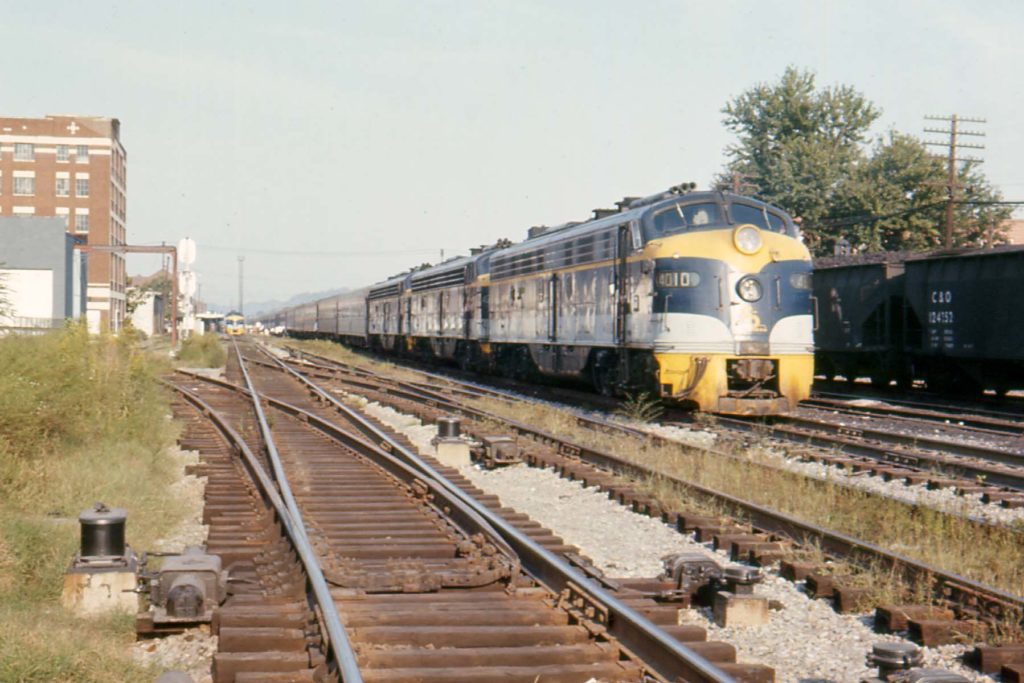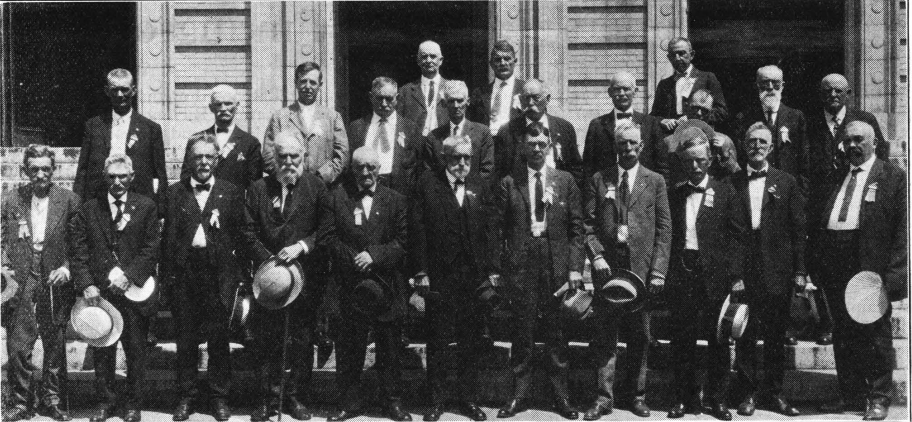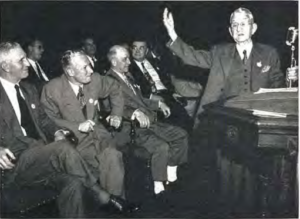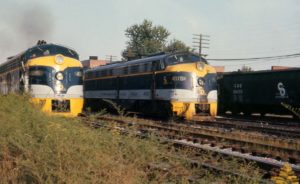
C&O E8 4010 along with sister units 4000 and 4005 with 21 cars preparing to leave for Detroit, MI after a day of fun for veterans at Camden Park in Huntington, WV. They can be seen loading up in the background. F. Douglas Bess, Jr.
As mentioned in a previous post, one of my favorite places to photograph trains was at the Huntington, WV station because of the proximity of my grandparents’ home to the station.
One Saturday afternoon in September, 1967, as I was arriving at the station, activity was going on like I had never seen before. Pullman sleepers from various railroads as well as C&O’s occupied both tracks at the station plus a few on the 10th Street spur just east of the station. Later investigation revealed that these were special trains that had carried veteran C&O employees to Huntington for a day of meetings and fun at Camden Park, West Virginia’s only amusement park located just west of the city limits of Huntington.
The veteran men and women who had 25 or more years service with the C&O consisted of telegraph operators, dispatchers, yard masters, clerks, conductors, engineers and maintenance of way personnel just to name a few. Spouses were included, so the meetings had a truly family atmosphere.

Special with C&O E8s 4015 and 4022 with 11 cars about to depart for Columbus, OH. F. Douglas Bess, jr.
The concept of an association of employees dates back to the presidency of George W. Stevens. Mr. Stevens became president of the C&O in 1900 succeeding Melville E. Ingalls. Stevens began his railroad service with the Baltimore & Ohio Railroad in 1864 and later with the Wabash, St. Louis & Pacific from 1873 until Ingalls appointed appointed Stevens as General Manager in 1890. He served in that capacity until Ingalls resigned over a management disagreement at which time Stevens assumed the presidency. Because Mr. Stevens came up through the ranks, he was well liked by employees who gave him the nickname “Uncle George.” As a general manager he was always on hand to handle the toughest of problems.
Each June 29th during the years he was president, Mr. Stevens invited officers of the company to his home, “Virginia Manor” to celebrate his birthday. It was located near Glasgow, VA, west of C&O’s Balcony Falls Yard along the James River. An idea came to Mr. Stevens one year that it would be nice if employees of the company could get together and become better acquainted. Mr. Stevens thought it would secure greater loyalty to one another as well as to the company. Thus was born the Chesapeake and Ohio Veteran Employees Association.
The association was founded in 1916 by Lyle G. Bentley. Mr. Bentley began his railroad service in 1896 as a telegrapher. By 1908 he was made superintendent of the Hospital Department. In 1913 he assumed the added duties of secretary of the General Safety Committee and editor (and founder) of the C&O employees’ magazine. In 1918 Bentley was made General Safety Agent and remained in that position until his retirement on July 1, 1947. He was instrumental in improving C&O’s safety record so much that it won the E.H. Harriman gold medal award one year. During his 51 year career, Bentley presided over the veterans association annual meetings and served as their president from 1947 to 1950.

GP7s 5893 and 5895 with 9 cars ready to pull special train for Hinton, WV September, 1967 This was the only special that carried all coaches as the trip home would arrive in the late evening hours. F. Douglas Bess,Jr.
On June 30, 1917, the first annual meeting of the association was held at the famed Greenbrier Hotel in White Sulphur Springs, WV. Seven years earlier, the C&O had purchased the historic resort property and in 1913 built the hotel. At the first meeting, 163 of the 253 charter members were present of which two were women. The association was organized with offices of president, vice president, secretary, assistant secretary and treasurer. A Constitution and By-Laws was implemented of which Section 1, Article 3 stated “Any person having been in the service of The Chesapeake and Ohio Railway Company and its predecessor companies for twenty-five years in aggregate shall be eligible for membership.” Annual dues were $1 and payable each year beginning in January.

First annual meeting of C&O Veterans at the Greenbrier in White Sulphur Springs, WV. Photo courtesy of the C&O Historical Society
Following the first meeting, President Stevens placed a notice in the September, 1917 issue of the C&O employees association magazine stating that he was surprised at the large turnout at the first meeting. He remarked that “a spirit of comradeship was developed and hoped next year’s meeting would be more largely attended.” Mr. Stevens also urged those present at the first meeting to encourage more eligible employees to join. Mr. Bentley, editor of the C&O employee magazine, printed excerpts of letters from employees who had nothing but praises for the meeting.
While no information was available for when and where the second meeting in 1918 was held, it could be assumed it took place at the Greenbrier Hotel.
The third annual gathering was held on Saturday, July 19th, 1919 at the Greenbrier. By this time it was necessary to add additional sleeping cars to regularly scheduled passenger trains.

Badges from various association meetings. Michael Rhodes Collection. Photo courtesy of Michael Rhodes.
The fourth annual gathering at the Greenbrier on Saturday, September 25, 1920 was attended by over 350 members. President Stevens announced at this meeting a new pension plan for employees. He shared with them that in appreciation of their faithful service and devotion to the railroad and its officials, they would receive a pension of one percent average of wages during the last 10 years multiplied by the number of years they had spent in service. He assured employees that they would retire with at least 40% of all that they were making. Sadly this would be his last time to meet with the veterans as Mr. Stevens passed away on the porch of his cottage at White Sulphur Springs on November 3, 1920 at the age of 69.
Again no information was available for the meetings from 1921 through 1923. However it could be assumed that they were held at the Greenbrier Hotel. Veterans with 50 years service in Huntington, WV for the 1924 meetings. Courtesy COHS
Veterans with 50 years service in Huntington, WV for the 1924 meetings. Courtesy COHS
Huntington became the host city on July 26, 1924 for the eighth annual meeting of the veterans. The city went all out to welcome the nearly 1,000 veterans, their spouses and their children. According to The Chesapeake and Ohio and Hocking Valley Employes’ Magazine, the veterans were treated royally. A local group called The Committee of 100 took the veterans and families with their own cars to local hotels and clubs where they were served breakfast. After that they were given a tour of the city and surrounding areas for an hour before ending up at the city auditorium for meetings. Later they were taken to Camden Park by car and streetcar for an old fashion picnic and fun. It was reported that everything went smoothly. By evening, it came time to board the trains back home for a tired but happy bunch.
On Saturday July 11, 1925 Cincinnati, OH was selected as the location for the meetings. Also the following year in August, 1926, the 10th meeting took place in Cincinnati. Thousands of members and their spouses were in attendance arriving by special trains.
Jumping ahead to 1947, apparently with the increasing number of veterans and their spouses attending the yearly meetings, there was not a venue available to handle them at one location. So it was decided to hold the 31st annual meeting on successive Saturdays in June in two locations. The first meeting took place on June 21 in Richmond, VA with 1,600 in attendance. It was held at the Mosque (now Altria) Theater. The second meeting in Cincinnati on June 28 had 2,250 in attendance. It was held at the Taft Theater. The Richmond meeting included those employees who lived and worked in Handley, WV and points east. The Cincinnati meeting included those west of Handley. Handley is located approximately 25 miles east of the capital city of Charleston and for many years served as a crew change point for freight trains.

L.G. Bentley being presented a gold wrist watch at the 1948 meeting for his service to the association.
The following year in 1948, the 32nd meetings were again held in Richmond and Cincinnati on June 19th and 26th respectively. Highlights of the meeting included honoring L.G. Bentley with a gold wrist watch commemorating his founding the association. Also he was re-elected president of the association for an unprecedented second time.
The 34th annual meeting again was held in Richmond and Cincinnati on the last Saturday in September and the first Saturday in October, 1950 respectively. The veterans were greeted by C&O President Walter J. Tuohy and other top executives of the company. President Tuohy ascended to the office in 1949 after previous president R. J. Bowman resigned due to illness. L.G. Bentley principal speaker and founder of the association was serving his last year as president of the association. A combined total of 4,100 veterans attended the meetings.
The 35th and 36th annual meetings were held in the Fall of 1951 and 1952 at the same venues as the 34th meeting. The combined 1951 meeting had just over 4,000 in attendance while the 1952 meeting had 4,600.

Ninety-two year old retired yard conductor H.E. Myers entertaining the crowd as C&O president Walter J. Touhy (seated second from left) looks on. COHS

President Touhy visiting with Logan Subdivision employees Ozias Lewis, Mose Patterson and Willie White at the 1951 meeting. Mr. Touhy visited with as many employees as time permitted. Courtesy COHS
Nineteen fifty-three marked the return of the annual meetings to a location that would accommodate all veterans. The Greenbrier Valley Fairgrounds (now the State Fair of West Virginia) in Fairlea, located south of Lewisburg, hosted the event. The veterans were welcomed by President Walter J. Tuohy along with several other officers. C&O Tracks Magazine noted that 10 special trains brought 5,000 veterans and their spouses from all over the Chesapeake District. The original C&O became known as the Chesapeake District after the merger of the Pere Marquette into the C&O on June 6, 1947. They arrived in Ronceverte and shuttle buses carried them to the fairgrounds from the station. It is interesting to note that former Pere Marquette veterans were still conducting their own meetings at this time.
No meeting was held in 1954 due to depressed business conditions, however in 1955 the Greenbrier Valley Fairgrounds served as host again for the 38th annual gathering of the C&O veterans with 4,000 in attendance. One highlight of the meeting was the recognition of the six Long brothers who all worked on the eastern part of the C&O. A seventh brother was unable to attend due to illness. Also the Greenbrier Valley High School band entertained the crowd. Twenty-seven churches from the Lewisburg and Ronceverte area supplied food which included 2,500 chickens, 15,000 rolls and 900 gallons of coffee.

The six Long brothers being recognized at the 1955 association gathering from left to right W.G., A.M., E.C., G.E., V.S., and W.S. Courtesy COHS
The 39th annual meeting was once again held at the Greenbrier Valley Fairgrounds in the fall of 1956. As before special trains brought approximately 5,000 veterans and their spouses to the fairgrounds. Tracks Magazine noted in the November issue that stock barns were converted to dining rooms. Twenty-one area churches prepared more than 5,000 complete chicken dinners and also lunches for the return trip.

Two retired 94 year old veterans were recognized at the 1955 meetings. On the left is Dr. R.S. Griffith and next to him is H.H. Woods. A number of retired vets enjoyed attending the meetings. Courtesy COHS
From 1957 through 1962 only four gatherings were held at unknown locations. However in 1963 Camden Park just outside the western city limits of Huntington, WV hosted the 43rd annual meeting of the veterans. No information was available attendance wise but I am sure everyone had a great time at West Virginia’s only amusement park. The 44th annual meeting was held at the Greenbrier Valley Fairgrounds.

Two examples of the many cars from the Pullman pool supplied to the C&O for the specials trains for the 1967 meeting. On the left is Southern Railway Cashiers Valley (a 14-roomette, 4-double bedroom) sleeper. On the right L&N Whispering Pine (a 6-section, 6-roomette, 4 double bedroom) sleeper. These two cars came to Huntington on regularly scheduled train 22-2 from Louisville, KY. F. Douglas Bess, Jr.
On September 15, 1967, Camden Park again hosted the 47th annual reunion of C&O veterans. The attendance was a staggering 6,000 people. Six special trains plus additional cars on existing C&O passenger trains did the honors. Lunch consisted of 2,500 chickens, 1,500 pounds of baked beans, 1,600 pounds of potato salad, 840 dozen rolls, 750 pounds of tomatoes, 650 gallons of coffee and 250 gallons each of soft drinks and iced tea. Noted speakers at the event included C. Vernon Cowan, VP Operations of C&O/B&O and Hayes T. Watkins, VP Finance and Accounting. Four years later Mr. Watkins would become CEO of C&O/B&O. The Baltimore & Ohio RR came under control of the C&O in 1963 however the event was basically C&O Ry employees. Mr. Cowan noted that “This is a C&O reunion, but we are no longer Chesapeake and Ohio. Our family is growing larger, embracing thousands of other fine railroad men and women on the Baltimore & Ohio, the South Shore (Chicago South Shore and South Bend) and soon hopefully the Western Maryland.”

Consist of specials arriving in Huntington on the morning of September 16, 1967. Information courtesy of Bob Withers.
Information and photos are scarce concerning equipment used to operate the specials during the years that the annual meetings were held. By the time of the 1967 meeting, the C&O relied on the Pullman pool to provide enough sleeping cars beyond the number that was still in C&O’s possession. Pullman cars used in the specials included those from the Seaboard Coast Line (Atlantic Coast Line and Seaboard Air Line), Great Northern, Louisville & Nashville, New Haven, Pennsylvania, Southern Railway, Southern Pacific and Union Pacific. That made for a total of 99 Pullmans and 16 locomotives. I was fortunate to have photographed some of these cars and locomotives.
Unfortunately no information is currently available whether the meetings continued beyond 1967. While the C&O and B&O were separate companies after C&O’s control of the B&O in 1963, some departments of both roads were being consolidated in either Huntington or Baltimore. A number of C&O employees based in Huntington were transferred to Baltimore and vice versa. By 1972, holding company Chessie System, Inc. was created to bring under one umbrella the C&O, B&O and by then the Western Maryland Railway. To have a combined veterans association meeting at one location or even split over a couple of weekends may not have been feasible, therefore the 1967 gathering may have been the last one.
In all the research that went into writing this piece, I just wanted to share a few observations:
- At each meeting, employees with 50 years service were recognized and presented diamond pins personally by the president or other high ranking officers of the C&O and gold passes to travel for free on the system.
- C&O executives at the meetings shared how the company was doing and praised the men and women who worked hard to keep the C&O to the high standards it enjoyed all of those years.
- The veterans association provided entertainment including bands, employee performances and the like while the C&O provided transportation to and from the events.
- Most meetings prior to 1953 were indoors and more formal than those from 1953 through 1967. Being outdoors during this period made it a more relaxed atmosphere which appears to have suited the veterans.
- Over a six year period from 1957 through 1962 only four meetings were held. No reason could be determined except it could have been for the same reason that the 1954 meetings were cancelled.
- Besides the Pere Marquette and the B&O, a number of other railroads had their own veteran employees association such as the Pennsylvania RR, Chicago & Northwestern and the Milwaukee Road.
The one thing that struck me about the meetings was that current and retired employees looked forward to them each year. It was a time they could get together and share their experiences and memories long before the days of cell phones and social media. Mr. Stevens remarked positively about the comradeship after the first gathering in 1917 and it seems to have carried over throughout the life of the association gatherings.
Acknowledgements:
- Tom Dixon with the Chesapeake and Ohio Historical Society who provided information and without whose help it would not have been possible to write this piece.
- Michael Rhodes who provided pictures of badges veterans wore at the meetings and other photos from the COHS archives.
- Bob Withers for providing consists of specials and copies of Chessie/B&O News for the 1967 gatherings and for making me aware what all the activity was about in Huntington.
- Chessie’s Road by Charles W. Turner which is a detailed history of the C&O up through the early 1950’s.




Recent Comments